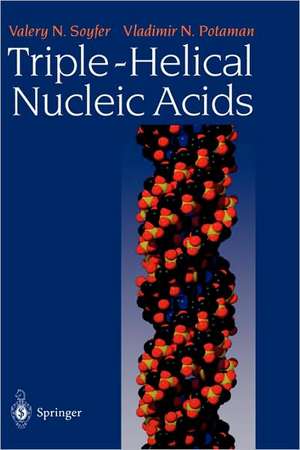Triple-Helical Nucleic Acids
Autor Valery N. Soyfer, Vladimir N. Potamanen Limba Engleză Hardback – 5 dec 1995
| Toate formatele și edițiile | Preț | Express |
|---|---|---|
| Paperback (1) | 894.03 lei 6-8 săpt. | |
| Springer – 31 oct 2011 | 894.03 lei 6-8 săpt. | |
| Hardback (1) | 954.14 lei 6-8 săpt. | |
| Springer – 5 dec 1995 | 954.14 lei 6-8 săpt. |
Preț: 954.14 lei
Preț vechi: 1163.58 lei
-18% Nou
Puncte Express: 1431
Preț estimativ în valută:
182.60€ • 189.19$ • 152.39£
182.60€ • 189.19$ • 152.39£
Carte tipărită la comandă
Livrare economică 22 martie-05 aprilie
Preluare comenzi: 021 569.72.76
Specificații
ISBN-13: 9780387944951
ISBN-10: 0387944958
Pagini: 360
Ilustrații: XIV, 360 p.
Dimensiuni: 155 x 235 x 23 mm
Greutate: 0.69 kg
Ediția:1996
Editura: Springer
Colecția Springer
Locul publicării:New York, NY, United States
ISBN-10: 0387944958
Pagini: 360
Ilustrații: XIV, 360 p.
Dimensiuni: 155 x 235 x 23 mm
Greutate: 0.69 kg
Ediția:1996
Editura: Springer
Colecția Springer
Locul publicării:New York, NY, United States
Public țintă
ResearchDescriere
The ability of DNA to exist in configurations other than its classical double-stranded form has been known for many years. There has been a spectacular recent surge of interest in these forms, notably in the three-stranded or triple-helical form. Triplex-like nucleic acids are now known to exist in vivo, and may well participate in significant biological processes. Interest in triple-helical nucleic acids has been greatly stimulated by their potential exploitation to control gene expression, serve as tools in genome mapping strategies, etc. The authors have written an encyclopedic introduction to nucleic acid triplexes based on many years of familiarity with the topic. The book includes information on chemistry, conformation, physical properties, applications, and hypotheses about the biological role of triplexes. It pays particular attention to the different methods for investigating these molecules, a feature which will be welcomed by those new to the field.
Cuprins
1. The Discovery of Triple-Stranded Nucleic Acids.- Basic Physicochemical Properties of Nucleic Acids.- Bases, Nucleosides, Nucleotides, Polynucleotides.- Base Pairs and Double-Stranded Nucleic Acids.- Some Methods of Investigating Nucleic Acids.- Circular and Superhelical DNA.- Physicochemical Studies of Model Triple-Stranded Structures.- The Discovery of Nucleic Acid Triplexes.- Physicochemical Studies of Model Triplexes.- Early Hypotheses About the Biological Roles of Triple-Stranded Nucleic Acids.- Studies of Nuclease S1 Susceptibility of Specific DNA Sequences.- Experimental Evidence That the S1-Sensitive PyPu Tracts in Supercoiled DNA Form Intermolecular Triplexes.- Intermolecular Triplexes Between DNA and Oligonucleotides.- Current Fields of Interest in Investigation of Triplexes.- 2. Methods of Triplex Study.- Physical Methods for Triplex Study.- Spectral Methods.- Differential Scanning Calorimetry.- Equilibrium Sedimentation.- Electrophoretic Techniques.- Immunological Methods.- Affinity Methods.- Affinity Chromatography.- Filter-Binding Assay.- Electron Microscopy.- X-Ray Analysis.- A Short Overview of Experimental Physical Methods for Triplex Studies.- Theoretical Descriptions of the Triplex Structures.- Enzymatic and Chemical Probing of Triplex Structures.- Analysis of Modifications Using Maxam—Gilbert Sequencing Gel Analysis.- Primer Extension Analysis.- Enzymatic Methods.- Single-Strand-Specific Nucleases.- DNase I Footprinting.- Inhibition of Restriction Nuclease Action.- Chemical Methods.- Unbound Agents.- Photofootprinting.- A Short Overview of Chemical and Enzymatic Probes.- Site-Directed Agents.- Nuclease-Like Oligonucleotides.- Photoactive Groups Attached to Oligonucleotides.- A Short Overview of Site-Directed Agents.- Conclusion.- 3. General Features of Triplex Structures.- Basic Types of Triplexes.- Nucleotide Sequence Requirements.- Intermolecular and Intramolecular Triplexes.- Molecular Details of Triplex Structure.- Major-Groove Location of the Third Strand.- Base Triads in Nucleic Acids.- Orientation of the Third Strand.- Overall Conformations of Triplexes.- Stabilization Common to Intramolecular and Intermolecular Triplexes.- Factors That Destabilize Triplexes.- Specific Features of Intramolecular Triplexes (H and H* Forms).- Specific Features of Intermolecular Triplexes.- DNA—RNA Triplexes.- Kinetics of Triplex Formation.- Thermodynamics of Triplexes.- New Variants of Triplex Structure.- Conclusion.- 4. Triplex Recognition.- Extension of Triplex Recognition Schemes.- Natural Bases in Unusual Triads.- Triplexes with Base and Nucleoside Analogs in the Third Strand.- Abasic Sites in the Third Strands.- Base Analog in the Duplex Part of the Triplex.- Alternate Strand Triplex Formation.- Modified Oligomer Backbones.- Modifications in the Sugar—Phosphate Backbone.- Conjugated Oligonucleotides.- Protein—DNA Interactions and Triplex Formation.- Triplex DNA—Drug Interactions.- Groove—Binders.- Intercalators.- Conclusion.- 5. The Forces Participating in Triplex Stabilization.- Triplex Stabilizing Factors.- Reduction of Interstrand Repulsion.- pH Stabilization.- Length-Dependence.- Differential Effect of Divalent Cations.- The Hydration State of Nucleic Acids.- Hydrophobic Substituents in the Third Strand.- Possible Interactions Which Favor and Stabilize Triplexes.- Electrostatic Forces.- Stacking Interactions.- Hoogsteen Hydrogen Bonds.- Hoogsteen Hydrogen Bond Enhancement.- Hydration Forces.- Contribution of Hydrophobicity.- Interrelation of Different Triplex-Stabilizing Contributions.- Conclusion.- 6. In Vivo Significance of Triple-Stranded Nucleic Acid Structures.- In Vivo Existence of Triplexes.- Search for Triplexes in the Cell.- Factors That Could Be Responsible for Triplex Formation In Vivo.- Possible Biological Roles of Triplexes.- Possible Regulation of Transcription.- Possible Regulation of Replication.- Possible Triplex-Mediated Chromosome Folding.- Structural Role at Chromosome Ends.- Recombination.- Possible Role in Mutational Processes.- Do PyPu Tracts Play a Role in RNA Splicing?.- Elements of Triple-Stranded Structure in RNA.- Other Roles of the PyPu Tracts.- Coding of Charged or Hydrophobic Amino Acid Clusters.- Can the PyPu Tracts Exclude Nucleosomes from Certain Gene Regions?.- Conclusion.- 7. Possible Spheres of Application of Intermolecular Triplexes.- Applications of Intermolecular Triplex Methodology.- Extraction and Purification of the Specific Nucleotide Sequences.- Affinity Chromatography.- Quantitation of Polymerase Chain Reaction Products.- Nonenzymatic Ligation of Double-Helical DNA Mediated by Triple Helix Formation.- Triplex-Mediated Inhibition of Viral DNA Integration.- Site-Directed Mutagenesis.- Detection of Mutations in Homopurine DNA Sequences.- Mapping of Genomic DNA.- Control of Gene Expression.- Conclusion.- References.
Recenzii
"A thriving new area of research in nucleic acids focuses on triple helical structures in DNA. The authors review what we know about most aspects of these novel structures, covering structural, molecular recognition and physico-chemical aspects in detail. Read the book to learn the structural aspects of triplexes..." Nature












